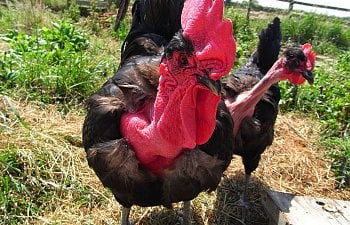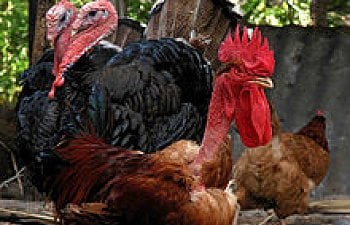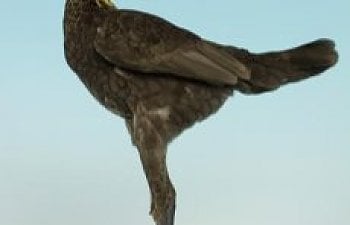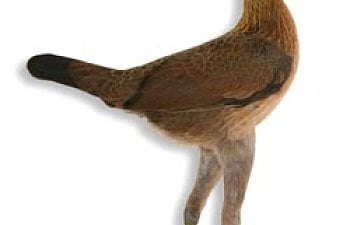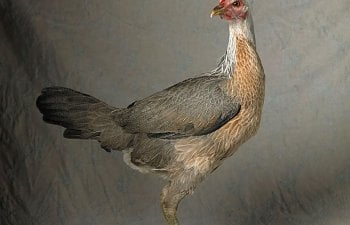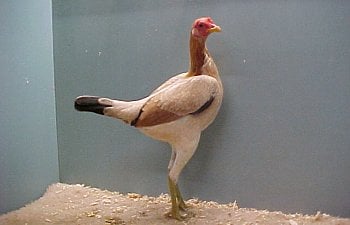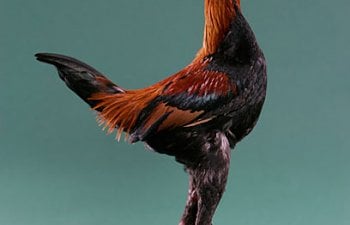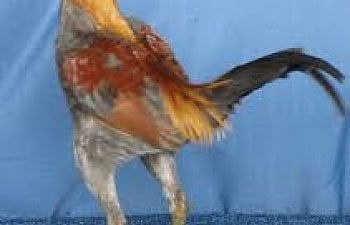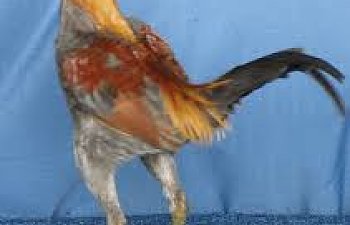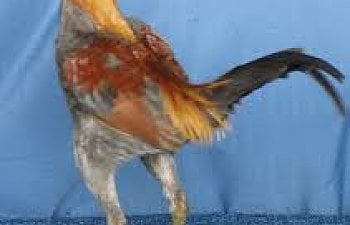There are many breeds of chickens, some are normal, and the type of chicken that comes to mind when you think of ‘poultry’. But here are five breeds who would be far from your mind when you think of ‘chicken’.
1. The Onagadori chicken

The striking and amazing Onagadori chicken originated in Japan, it’s meaning ‘honorable chicken’ or ‘long tailed chicken’. The Japanese government designates the breed as a Special Natural Monument. The Onagadori is often confused with the Phoenix, which is a direct descendant. They are extremely rare outside of Japan.
They come in four beautiful colors:
Black breasted red

Black breasted silver

Black breasted golden

White

Don’t you just love those tail feathers? You might be wondering how they could grow so long if chickens molt. Well Onagadoris don’t!
Their anscestor is the green jungle fowl. The non-molting gene (and propensity to perch) are derived from this breed. Through selective breeding for usually long saddle, sickle and tail feathers in roosters were achieved. In the very purest of the breed, and under the best housing (which protects the rooster from weather, dirt, and wear) these feathers never molt. Tail, saddle, and sickle should grow constantly. The tail feathers can be anywhere from 12-27 feet. Isn’t that amazing? Because of this, breeders and owners must provide high perches and a clean dry enclosure to protect the tail feathers. Sometimes, they are rolled up and secured for protection. A very small percentage of the roosters feathers molt annually, but due to selective alternations in basic DNA and special care, the molt cycle lasts about 3-4 years. Hens molt normally.
2. Modern Game

This interesting bird originated England, between 1850 and 1900. The Modern Game came about after the ban on cockfighting. Now, instead of breeding fighting birds, breeders began breeding show birds. And that’s how the Modern Game was born.
They are strictly ornamental show birds. They also make wonderful backyard pets. They are great for the garden, due to their long legs they don’t scratch as much, and they tame easily. However, they must have special care during cold weather. Their close tight feathering does not make them very winter hardy. Broodiness should be discouraged, again due to the feathering. If your Modern Game wishes to hatch, she will need a very small clutch so she will be able to keep them warm.
They come in 13 different color variations:
Birchen

Black

Black-Red

Blue

Blue-Red

Brown-Red

Lemon-Blue

Pile

Silver-Blue

Silver Duckwing

Gold Duckwing

Wheaton

White

3. Transylvanian naked neck, or Turken

This bird is certainly interesting, and will pop out at any visitor to your flock. The Transylvanian Naked Neck, or Turken, was largely developed in Germany. They are fairly common in Europe, rare in North America, and prevalent in South America. Other breeds of Naked Neck, such as the French Naked Neck, which is often confused with the Transylvanian, and the Naked Neck gamefowl.
The name Turken was from a mistaken idea that this bird was a hybrid of a turkey and a chicken. That Naked Neck is devoid of feathers on its neck, vent, and part of the breast. It may come as a surprise, but this bird is surprisingly cold hardy, but the owner must still have caution and watch to make sure they are comfortable.
These birds do not have a strong setting instinct. Nor do they produce many eggs, laying a reasonable 120-150 eggs per year. They are great for free ranging, as they are flightless.
While the Naked Neck trait is dominant and controlled by one gene (making it easy to introduce into other breeds), any crosses will be determined as hybrids. Naked Necks come in three simple color variations:
White

Black

Speckled

4. Featherless chicken

I’m only going to touch briefly on this crazy looking breed.
The featherless chicken was developed by scientists. And you can probably guess that it was created to eliminate the irksome task of pulling out feathers in the meat industry.
However easy this trait may make it to mass produce more meat, in many people’s opinion (and mine) it is seemingly cruel. Males may be unable to mate, because they cannot flap their wings. It is obvious that sunburn will be an issue, as well as bug bites and parasites.
Surprisingly, this bird was not genetically modified. The featherless trait comes from a natural breed whose characteristics have been known for more than 50 years.
5. Dong Tao

Isn’t this breed absolutely shocking?
This bird originated in Vietnam, where it is also called “dragon chicken”. It’s enlarged legs are a delicacy there, being crispy and delicious. It takes them 8 months-1 year for them to reach slaughter weight, at 3-5 kg.
A pair of Dong Taos can cost $2,500, being in short supply and high demand. They are very difficult to hatch, because of their large legs, which can be as thick or thicker than a human wrist, will crush eggs, they must be hatched in an incubator. They are hard to breed as well, again, having to do with their legs. It takes time and effort to raise this breed, but many people say it’s worth it.
Dong Taos are not good layers, nor do they like captivity, and in confinement will fight. They come in two colors each in Vietnam:
Males-glossy black and yellow
Females-plum and white

I hope you learned something and enjoyed reading this!
Lastly, I’d like to thank @KikisGirls and @casportpony for all their help with this article. I’m new at this and had some trouble, so I’d like to say a huge thank you to them for their patience and help!
1. The Onagadori chicken
The striking and amazing Onagadori chicken originated in Japan, it’s meaning ‘honorable chicken’ or ‘long tailed chicken’. The Japanese government designates the breed as a Special Natural Monument. The Onagadori is often confused with the Phoenix, which is a direct descendant. They are extremely rare outside of Japan.
They come in four beautiful colors:
Black breasted red
Black breasted silver
Black breasted golden
White
Don’t you just love those tail feathers? You might be wondering how they could grow so long if chickens molt. Well Onagadoris don’t!
Their anscestor is the green jungle fowl. The non-molting gene (and propensity to perch) are derived from this breed. Through selective breeding for usually long saddle, sickle and tail feathers in roosters were achieved. In the very purest of the breed, and under the best housing (which protects the rooster from weather, dirt, and wear) these feathers never molt. Tail, saddle, and sickle should grow constantly. The tail feathers can be anywhere from 12-27 feet. Isn’t that amazing? Because of this, breeders and owners must provide high perches and a clean dry enclosure to protect the tail feathers. Sometimes, they are rolled up and secured for protection. A very small percentage of the roosters feathers molt annually, but due to selective alternations in basic DNA and special care, the molt cycle lasts about 3-4 years. Hens molt normally.
2. Modern Game
This interesting bird originated England, between 1850 and 1900. The Modern Game came about after the ban on cockfighting. Now, instead of breeding fighting birds, breeders began breeding show birds. And that’s how the Modern Game was born.
They are strictly ornamental show birds. They also make wonderful backyard pets. They are great for the garden, due to their long legs they don’t scratch as much, and they tame easily. However, they must have special care during cold weather. Their close tight feathering does not make them very winter hardy. Broodiness should be discouraged, again due to the feathering. If your Modern Game wishes to hatch, she will need a very small clutch so she will be able to keep them warm.
They come in 13 different color variations:
Birchen
Black
Black-Red
Blue
Blue-Red
Brown-Red
Lemon-Blue
Pile
Silver-Blue
Silver Duckwing
Gold Duckwing
Wheaton
White
3. Transylvanian naked neck, or Turken
This bird is certainly interesting, and will pop out at any visitor to your flock. The Transylvanian Naked Neck, or Turken, was largely developed in Germany. They are fairly common in Europe, rare in North America, and prevalent in South America. Other breeds of Naked Neck, such as the French Naked Neck, which is often confused with the Transylvanian, and the Naked Neck gamefowl.
The name Turken was from a mistaken idea that this bird was a hybrid of a turkey and a chicken. That Naked Neck is devoid of feathers on its neck, vent, and part of the breast. It may come as a surprise, but this bird is surprisingly cold hardy, but the owner must still have caution and watch to make sure they are comfortable.
These birds do not have a strong setting instinct. Nor do they produce many eggs, laying a reasonable 120-150 eggs per year. They are great for free ranging, as they are flightless.
While the Naked Neck trait is dominant and controlled by one gene (making it easy to introduce into other breeds), any crosses will be determined as hybrids. Naked Necks come in three simple color variations:
White
Black
Speckled
4. Featherless chicken
I’m only going to touch briefly on this crazy looking breed.
The featherless chicken was developed by scientists. And you can probably guess that it was created to eliminate the irksome task of pulling out feathers in the meat industry.
However easy this trait may make it to mass produce more meat, in many people’s opinion (and mine) it is seemingly cruel. Males may be unable to mate, because they cannot flap their wings. It is obvious that sunburn will be an issue, as well as bug bites and parasites.
Surprisingly, this bird was not genetically modified. The featherless trait comes from a natural breed whose characteristics have been known for more than 50 years.
5. Dong Tao
Isn’t this breed absolutely shocking?
This bird originated in Vietnam, where it is also called “dragon chicken”. It’s enlarged legs are a delicacy there, being crispy and delicious. It takes them 8 months-1 year for them to reach slaughter weight, at 3-5 kg.
A pair of Dong Taos can cost $2,500, being in short supply and high demand. They are very difficult to hatch, because of their large legs, which can be as thick or thicker than a human wrist, will crush eggs, they must be hatched in an incubator. They are hard to breed as well, again, having to do with their legs. It takes time and effort to raise this breed, but many people say it’s worth it.
Dong Taos are not good layers, nor do they like captivity, and in confinement will fight. They come in two colors each in Vietnam:
Males-glossy black and yellow
Females-plum and white
I hope you learned something and enjoyed reading this!
Lastly, I’d like to thank @KikisGirls and @casportpony for all their help with this article. I’m new at this and had some trouble, so I’d like to say a huge thank you to them for their patience and help!

